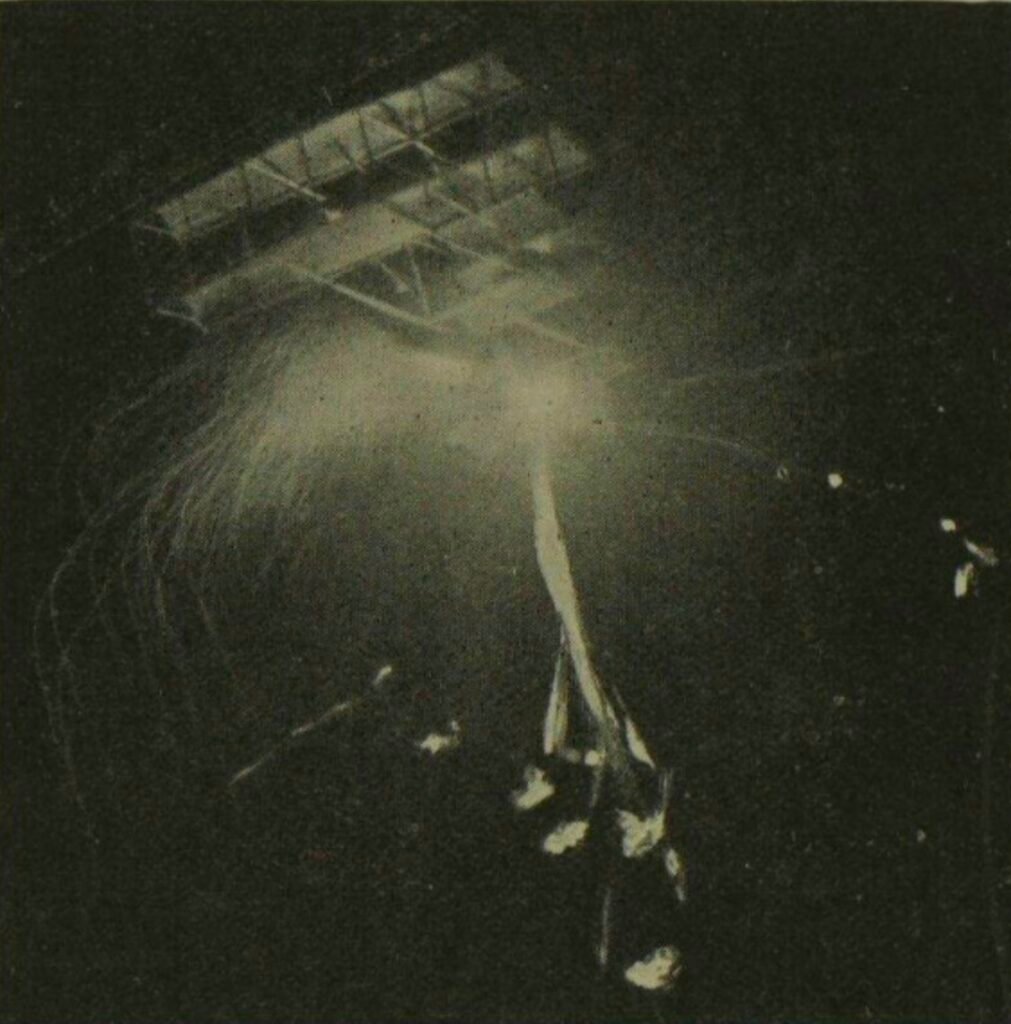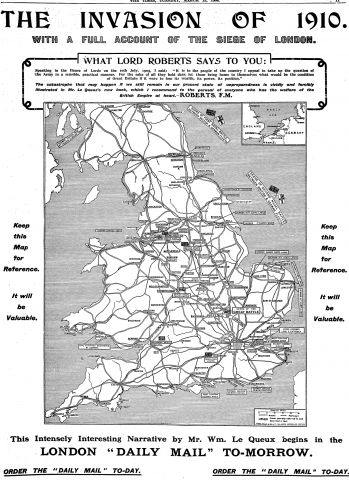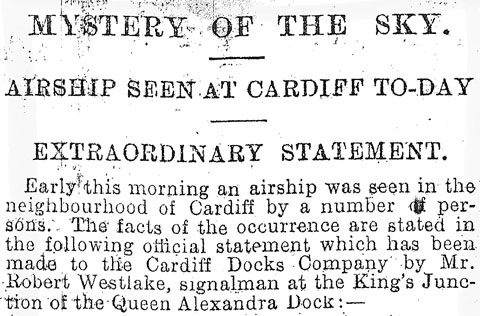
This photo, according to the Illustrated London News, shows ‘THE FIRST SHELL DISCHARGED FROM AN AEROPLANE OVER ENGLAND’.((Illustrated London News, 12 June 1909, 7. Another version of the same photo appears in Daily Mirror (London), 5 June 1909, 4.)) But it doesn’t really, because the ‘aeroplane’ almost certaintly wasn’t real but a non-flying mock-up strung on a wire or something, and while the ‘shell’ no doubt contained gunpowder it probably wouldn’t have done much damage unless it happened to blow up directly in your face.((The word ‘bomb’ existed but was only just becoming associated with aerial warfare.)) This was June 1909, and the ‘aeroplane’ was part of a nightly (except Saturdays) live action pyrotechnic entertainment at the Crystal Palace’s football ground called Invasion, described in an advertisement in the Globe as a:
COLOSSAL SIGHT. ABSOLUTE NOVELTY.
BATTLE OF THE FUTURE.
BOMBARDMENT BY AIRSHIPS.
A VILLAGE DESTROYED.
NOVEL SET PIECES.
A REAL TREAT FOR FOREIGN VISITORS.((Globe (London), 17 June 1909, 9.))
Of which last the Westminster Gazette wrote sardonically, ‘We admire that final touch. England is destroyed to make a foreign holiday’.((Westminister Gazette, 10 July 1909, 3.))
The Globe provided a narrative which makes it clear that Invasion conformed to many of the established tropes of the invasion genre — the enemy within of Le Queux, the Englishman’s home of du Maurier — while adding a vaguely Wellsian war in (or from) the air:
The scene opens in a quiet Surrey village, towards the close of the day. Villagers and Territorials are on the green, and some effective Maypole dancing and marching is seen. Then, as night falls the villagers retire to their homes and the Territorials to camp, and soon all is still. The silence of the night is broken by a signal fired by a spy in the village to an enemy in the air who rapidly approach in balloons, airships, and aeroplanes of all kinds. The Territorials are aroused, and a terrific battle ensues, the like of which has never been seen, and, it is to be hoped, never will be in reality. The defending soldiers are aided by a gun, especially invented for firing at air vessels, which most opportunely happens to be on the spot. In the end, after a terrific and most realistic battle, the enemy are overcome, their airships destroyed, and England is safe.((Globe (London), 23 July 1909, 4.))
The Sportsman‘s account of Invasion was a little more vivid, even bloodthirsty:
Aeroplanes drop bombs, houses burn, villagers scream, and the guns of the Territorials and foemen are firing fast and furious, whilst mines are exploded, and for noise and flash and fire the scene is as realistic as one could wish. In the end the British flag wins, and though destroyed buildings and wounded men are as thick as blackberries in autumn the audience rejoices in the supremacy of the old flag.1
This does sound rather like a Hendon set-piece, but mounted well before the war rather than after it.
Invasion seems to have done well enough in commercial terms — it ran through to the end of September, and there are various small press items through the summer spruiking it for Bank Holidays and the like.((Ibid., 22 September 1909, 1.)) But despite being ‘red-hot in up-to-dateness’, as the Sportsman put it — it opened a month after the 1909 phantom airship panic, and a month before Blériot’s Channel flight — this large-scale, spectacular and dramatic popularisation of the possibilities of aerial warfare seems to have attracted little interest from the nascent airpower lobby.((Ibid., 20 July 1909, 3.)) Perhaps such sniffiness is to be expected where popular entertainment is concerned. And yet it does appear that Invasion had some serious thought behind it — as I’ll discuss in a future post.
![]() This work is licensed under a Creative Commons Attribution-NonCommercial-NoDerivatives 4.0 International License.
Permissions beyond the scope of this license may be available at http://airminded.org/copyright/.
This work is licensed under a Creative Commons Attribution-NonCommercial-NoDerivatives 4.0 International License.
Permissions beyond the scope of this license may be available at http://airminded.org/copyright/.





